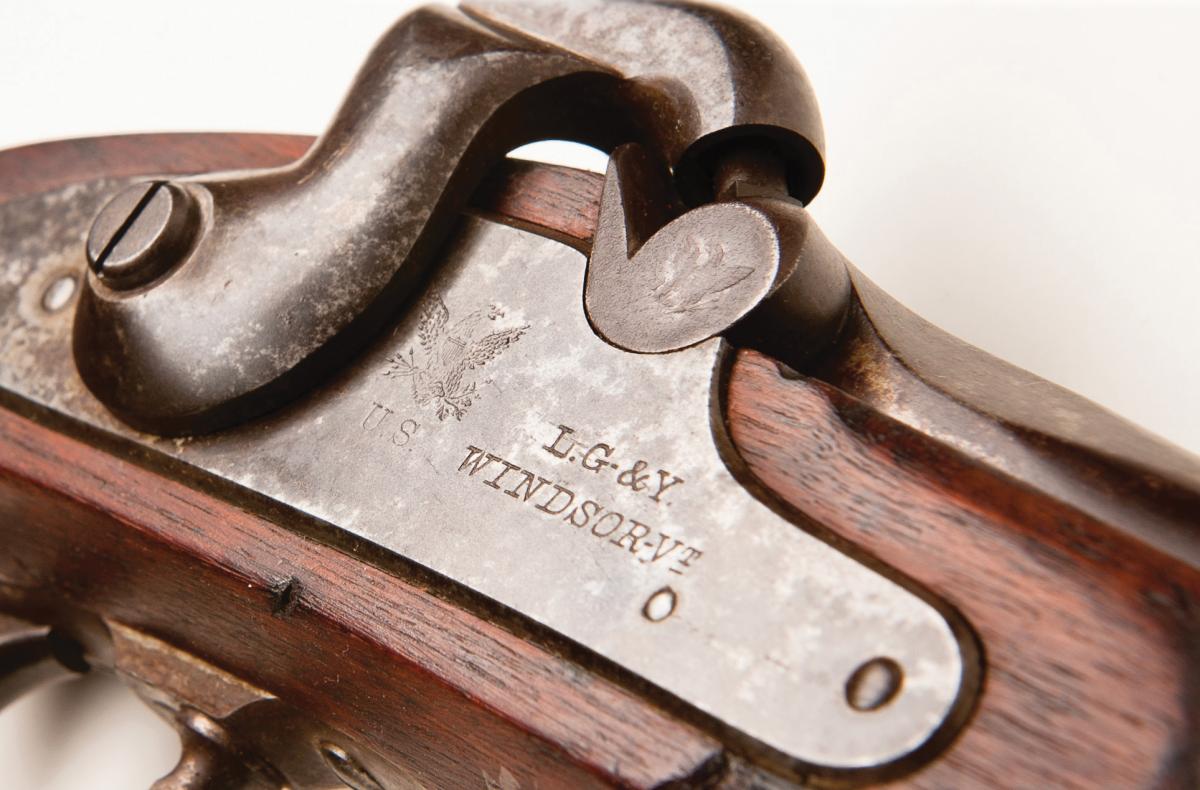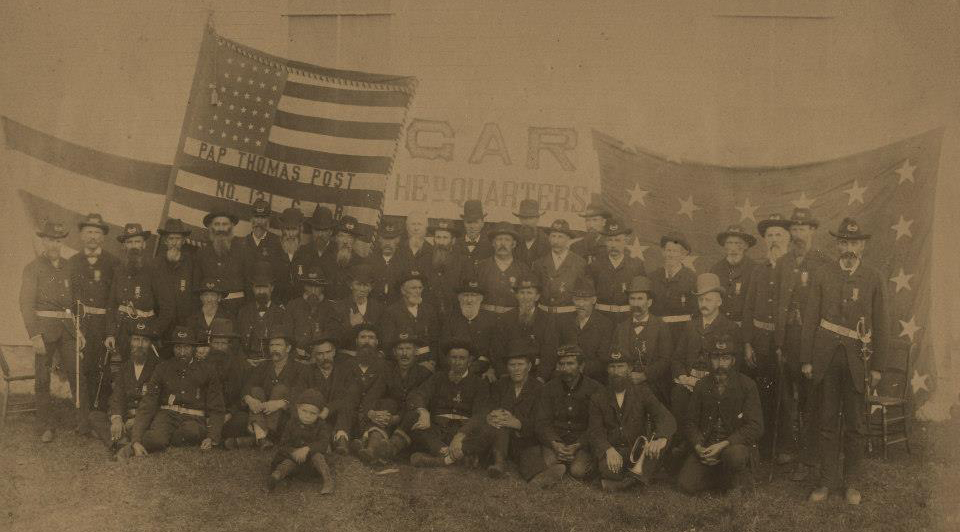By David Kummer
My family moved into a newly built colonial style home in 1966, the summer before my junior year in high school. Our house had a family room with a large wood burning fireplace, a first for us. When decorating the new room my father, Hudson Kummer, mounted an old flintlock rifle “long gun” over the fireplace that my grandfather, Philip I. Volkmer, gave him to display. I don’t recall that anyone ever mentioned that the rifle had belonged to my grandfather’s grandfather, that came much later. The gun remained mounted over my parents fireplace for the entire time that they lived there.
After my father retired in 1987 my parents decided to downsize from the large family home we had enjoyed for many years since it was much too big for just the two of them. Some years after my father died in 1997 my mother, Donna Kummer, asked me to get something for her from a laundry room closet and I noticed my grandfather’s rifle leaning against a wall in the corner of the closet, I recognized it immediately and took it out so I could see it closer. Glued to the wooden stock of the rifle was a small yellowed piece of paper which I had never seen before because it was not visible when the rifle was mounted over the fireplace of our colonial home. Handwritten on the paper was the following:
“GUN CARRIED BY PVT. PHILIP VOLKMER DURING THE SIVEL WAR, MICHIGAN 29TH REGIMENT”
My mother said that she had forgotten that it was in the closet and she offered it to me. I enthusiastically thanked her as this was a family heirloom and a nostalgic reminder of my grandfather who I loved dearly.

Grandpa Philip I. Volkmer was the second spouse of my grandmother. Leone Volkmer married her first spouse, Howard Kummer, in 1924 and raised two children with him in Flint, Ml. Hudson Kummer, my father, was born in 1925 and his younger brother, Keith Kummer, was born in 1929.
I never had the opportunity to know my dad’s father, Howard. He died in 1940 at age 47 when my father was only 14 years old, leaving my grandmother a widow at age 36.
Almost a decade later, my grandmother was introduced to Phil Volkmer, also a widower, by a family friend and they married in 1949 when he was 60 years old.
His first wife had died in 1946 and he had a daughter, Lenora, from that marriage who was born in 1918.
I was born in 1950, followed by sister, Kathleen, in 1951, and brother, James, in 1954. I would not be exaggerating to say that we lived a wonderful childhood during the 1950’s and 60’s and were lucky to have all four of our grandparents in our lives until we were in our 20’s.
Grandpa Volkmer passed away in 1973 at age 84. When my mother and I talked in later years about him she explained that he could not have been happier when his grandchildren were born as he had never expected that his life would change so greatly as it did after he married my grandmother.
I decided to research the history of the rifle with the clues that it offered.

The black walnut stock .58 caliber single shot musket/rifle is 59 inches long. It has a ramrod and a two leaf rear sight and small blade front site. Engraved on the side of the metal receiver is the date “1862”, a Federal eagle with “US” under it, and the name of the manufacturer, “L, G & Y. , Windsor, Vt”
The LG&Y musket was a product of the arms manufacturing firm of E. G. Lamson, A. F. Goodnow and 8. 8. Yale with forging facilities at Windsor, Vermont and machine shops in Shelburne Falls, Massachusetts. LG & Y manufactured 50,000 of these longarm muzzleloaders during the years 1862 thru 1864.
I wanted to learn more about the soldier Pvt. Philip Volkmer so I began researching the Wildwood Cemetery records in Chesaning, Saginaw County, Michigan, where my grandfather is buried. In addition to my grandfather Philip’s gravesite I also found the grave for his grandfather, Philip Volkmer, his father, William C. Volkmer, and many other Volkmer family members.
The senior Philip Volkmer was born in Germany on December 21,1831. He immigrated to New York in 1847 at the age of 16. He was married in 1852 at age 21 to Mary Wentz Volkmer, age 15. He moved to Chesaning from Buffalo, NY in 1861, 8 years before the Village of Chesaning was incorporated.
On August 10, 1864, at the age of 33, he enlisted in Company C of the 29th Regiment Michigan Volunteer Infantry which was raised entirely in the Sixth Congressional District by the Congressman John Driggs. The Regiment was organized at East Saginaw, Ml. and mustered on October 3,1864
An article in THE CHESANING ARGUS dated August 22, 1896, by O.W. Damon
adds some historical perspective:
“ . . .the first company of boys that enlisted from the Township of Chesaning, Michigan were formed in line in front of the old Chesaning Hotel preparatory to taking their departure for the seat of war to do battle for the cause of liberty and freedom, and the preservation of the Union. There were 16 in this company most of whom had not yet arrived at the age of their majority, but who were full of patriotism and were anxious to go. A considerable number of citizens had assembled to witness the same. Relatives and immediate friends were there with numerous momentoes in the shape of needle cases, pincushions, bouquets, etc.. Tears were seen profusely trickling down the saddened cheeks of mothers, sisters and others, not because they were going to war, but for fear they might never return. The word of command “Forward March” was finally given and the boys started towards Saint Charles, thence by a small steamer down the Bad River to Saginaw amid the cheers, the waving of handkerchiefs, shouts of “God bless you boys” of citizens on the one hand, and the tears and sorrow and saddened feelings of relatives and friends on the other, which made a scene never to be forgotten by all who were than present.
Subsequently at different times other boys in listed as also did some men of families, some going into the infantry and some into the cavalry service, until we find the upward of 50 were credited to the quota of Chesaning during the war. And be it known, and I say it to the credit of the citizenship of the Township of Chesaning that every man was a volunteer. Some of these boys never returned. Some were killed in battle, some were accidentally killed, some starved to death in Libby person, some died of disease before hey reached the stage of action, others were discharged for disability, returning to their homes soon to die of disease contracted in the line of duty, while yet others who served out their term of enlistment and were honorably discharged, have since died, whose remains in several instances lie buried in Wildwood cemetery.”
A history of the 29th Regiment by Gordon Thorsby reflects the following:
“With the onset of Civil War, it is often an assumption that regiments raised in 1864 saw little combat but from May of 1864 to April of 1865 as many casualties occurred in 11 months than the entire war previous two and half years. The war at this time was deadly, vicious, and inhuman.
The 29th Regiment mustered in at East Saginaw on September 3,1864, and after one month of continued recruiting, they broke camp. Their rail transport proceeded to the Nashville, TN just in time for Confederate John Bell Hood’s Fall offensive into Tennessee. Hood’s Army of 30,000 was headed straight for Nashville and the 29th would be surely involved in the defense.
The first assignment for the 29th Michigan was to proceed to Decatur, Alabama and join a small force to block Confederate General Hood’s route. The men of the 29th arrived in Decatur and immediately occupied newly dug rifle pits when Confederate troops assaulted that day. Every Butternut advanced through fog but was repulsed and Hood decided to prevent further casualties and bypassed the brave small force of defenders. The 29th had performed admirably in their first engagement. With the Confederate army headed north, the 29th’s need was also north and they were sent to Murfreesboro, TN arriving on November 27th. The historical battles of Spring Hill and Franklin happened a few miles away on November 29-30 and the garrison at Murfreesboro was cutoff while Nashville was under siege.
On December 5-7, a large Southern force attacked Murfreesboro and the 29th was dispatched west of Murfreesboro to a place called Overall Creek to create a demonstration but the expedition was fully isolated. While covering the crossing, the Battle of the Cedars took place where a strong force under command of Confederate General Nathan Bed ford Forrest was turned back at Murfreesboro. On the 13th, the regiment was dispatched to escort of a railroad train and procure wood for the locomotive, when they were set upon by a superior force of infantry and artillery near Winstead Church. Outnumbered two to one, the Union force fought off the Confederate attack. The regiment lost 17 total casualties.
During the fight, Confederates put a cannonball into the locomotive, disabling it, and tore up tracks. The 29th re-laid the tracks and they resolved the locomotive problem by hauling it by hand almost twelve miles back to Murfreesboro.
They were not done with fighting yet. On December 15th and 16th, they were again attacked while guarding another train near Alexandria on the Shelbyville Pike. The locomotive engine was a sitting duck because it was out of fuel and the boys in blue of the 29th got the train moving again and they were able to return under the protection of Ft. F3osecrans. However, it was not a peaceful venture. A brigade of Confederate advanced in several places only to be beaten off. The green regiment had become in very short order, a veteran regiment.
They were then assigned to guarding the Nashville and Chattanooga rail line until July,1865, then moved to Murfreesboro (TN) until September 6th when they were mustered out of the service, returning to Michigan, arriving in Detroit (MI) on the 8th where they were paid off and disbanded on the 12th (December).”

Grand Army of the Republic, Pap Thomas Post 121.
After his return from military service in 1865 at age 34, Philip went on to lead a long life. An 1877 map of Chesaning found in an Atlas of Saginaw County Michigan shows that Philip owned 40 acres of land just East of town. The 1880 Census for the Village of Chesaning states that Philip, age 48, was a farmer and that he lived with his wife, Mary, age 43, and several children, George (19), Lenora (16), Peter (13) and Mary (5) living at home. A son, William, who was born before the war, was married and lived nearby.
William had an early desire to join the Civil War effort with his father. An article in the OWOSSO ARGUS PRESS on June 19,1933, reports an annual event being held in Saginaw, MI:
” Again William Volkmer, justice of the peace at Chesaning, marched with the drum and bugle corps. For the past 8 years he has been a drummer of the state G.A.R. fife and drum corps. Not one member of the 5,000 delegates of the Grand Army of the Republic and Veterans of Foreign War took more active part in Saginaw than Bill Volkmer, whose steady, firm tread belie the fact that he was past 77 years of age.
Mr. Volkmer, who was born in Buffalo, NY, December 24,1855, is the last survivor of a colony from Buffalo, which came to Chesaning in 1861. With the civil war a reality, “Young Bill”, eight years of age, wanted to “go” as a drummer boy. His parents refused their consent, although many youngsters of tender years had gone with the troops. In 1890 his longing to drum became a reality and he organized a drum and fife corps of 10
members.”
The 1900 Census reports that Philip, age 68, was a widower living with his daughter Mary, a school teacher age 26, and daughter Lenora, age 17. His wife Mary, age 62, had died on February 24, 1900
Civil War Veteran Philip Volkmer died in St. Charles, Ml on January 10,1908, at age 76. Burial was at Wildwood Cemetery.
His son, William, died on September 17,1941 at the age of 86
SOURCES:
Civil War Notes; Gordon Thornsby (https://www.gordonthorsbycivilwarnotes.com)
Shrouds of Glory; Groom, Winston; Grove Press; 2004.
History of the 29th Michigan Volunteer Infantry; Belknap, William; Bentley Library; University of Michigan; 1908
